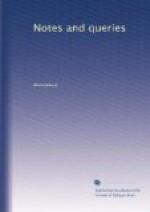“Archiepiscopus vero Cantuariae praesenti consensit electioni, ut omnes praelati et archiepiscopus quidem assumpto themate, Vox populi Vox Dei, sermonem fecit populo, exhortans omnes ut apud regem regum intercederent pro electo.”—Tho. Walsingham, Hist. Angl. ed. Camden, p. 126.
DANIEL ROCK.
A living Dog better than a dead Lion.—I no not know whether your correspondent (No. 22. p. 352.) ever goes to church; but if he is not prevented by rain next St. Swithin’s day, he will learn who was the author of this proverb. It will be a good thing, if your work should sometimes lead your readers to search the Scriptures, and give them credit for wisdom that has flowed from them so long, and far, and wide, that its source is forgotten; but this is not the place for a sermon, and I now only add, “here endeth the first lesson” from
ECCLESIASTES.
["J.E.,” “D.D.,”
and other correspondents, have also replied
to this Query by references
to Eccl. ix. 4.]
Curious Monumental Brass (No. 16. p. 247.)—If “RAHERE” will turn to Mr. Boutell’s Monumental Brasses and Slabs, p. 148., he will there find a description as well as an engraving of what, from his account, I doubt not he will discover to be the identical fragment to which he refers. A foot legend, and what remains of a border inscription, is added to it. In the above work, pp. 147 to 155, and in the Oxford Architectural Society’s Manual for the Study of Brasses, p. 15., “RAHERE” will find an account and references to numerous examples of palimpsest brasses, to which class the one in question belongs.
I presume that “RAHERE” is a young brass-rubber, or the fact of a plate being engraved on both sides would have presented no difficulty to him.
ARUN.
[We have received several
other replies to this Query,
referring to Mr. Boutell’s
Monumental Brasses: one from
“W.”; another
from “A CORNISHMAN,” who says,—
“The brass in question, when I saw it last, had been removed from the Rectory and placed in the tomb of Abbot Wheathampstead, in company with the famous one of Thomas Delamere, another Abbot of St. Albans.”
Another from “E.V.,” who states,—
“Other examples are found at St. Margaret’s, Rochester (where the cause of the second engraving is found to be an error in costume in the first), St. Martins at Plain, Norwich, Hedgerly Church, Bucks, and Burwell Church, Cambridgeshire. Of this last, an engraving and description, by Mr. A.W. Franks, is given in the fourteenth part of the Publications of the Cambridge Antiquarian Society.”
One from “WILLIAM SPARROW SIMPSON,” who says,—




